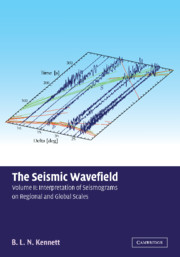Book contents
- Frontmatter
- Contents
- Preface to Volume II
- Part III Local and Regional Events
- Part IV Global Wave Propagation
- 24 The Nature of the Global Wavefield
- 25 Body Waves in the Mantle
- 26 Body Waves and the Earth's Core
- 27 Surface Waves and Modal Analysis
- 28 Receiver Based Studies
- 29 Analysis of Seismic Records
- Part V The Three-dimensional Earth
- Appendix Paths and Travel times
- Bibliography
- Index
29 - Analysis of Seismic Records
from Part IV - Global Wave Propagation
Published online by Cambridge University Press: 31 August 2019
- Frontmatter
- Contents
- Preface to Volume II
- Part III Local and Regional Events
- Part IV Global Wave Propagation
- 24 The Nature of the Global Wavefield
- 25 Body Waves in the Mantle
- 26 Body Waves and the Earth's Core
- 27 Surface Waves and Modal Analysis
- 28 Receiver Based Studies
- 29 Analysis of Seismic Records
- Part V The Three-dimensional Earth
- Appendix Paths and Travel times
- Bibliography
- Index
Summary
The analysis of seismic records depends on being able to disentangle the influence of the source and the structure of the Earth. Effective source characterisation thus becomes an important prerequisite for gaining new information on earth structure. Conversely, knowledge of the structure of the Earth is essential for providing estimates of the location of seismic events and the quantitative assessment of source mechanisms.
The need to know both the structure of the Earth and the properties of the source with only the information available from seismograms has dictated the development of seismology. Improved source locations have led to better Earth models, which in turn have been used to extract more information on all aspects of the source.
Seismic source estimation
The major part of the information used in the location of a seismic event is a set of arrival times of seismic phases which has been measured from displays of seismic waveforms by experienced analysts. For seismic arrays it is possible to provide additional information such as the apparent azimuth of the arriving energy and its velocity across the array.
For each seismic station the object is to provide arrival times (and array information) for a number of different seismic phases which have followed different propagation paths through the earth, together with an indication of the likely character of the arrival. Particular effort is made to try to extract information which is sensitive to the depth of the event, e.g., by recognising the phases pP, sP which are reflected back from the surface above the source.
The initial identifications of phase character may need to be modified when information from many stations are combined. One of the most difficult tasks has then to be faced. From the assemblage of arrival time picks, azimuth, and apparent velocity, those readings fromdifferent stations which should be grouped together have to be recognised and a preliminary location assigned. This location will then be refined by matching the patterns of observed and predicted arrival times.
Around the globe, many different seismic events can occur in a given time period so there is no guarantee that all readings correspond to the same event.
- Type
- Chapter
- Information
- The Seismic WavefieldVolume II: Interpretation of Seismograms on Regional and Global Scales, pp. 353 - 398Publisher: Cambridge University PressPrint publication year: 2002



